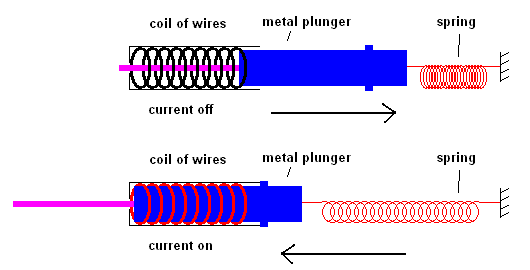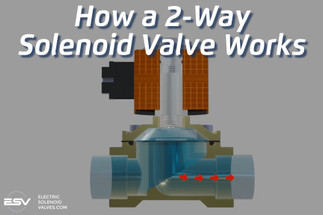Aug 19th 2022
How a 2-Way Solenoid Valve Works
One of the most commonly used types of valves used today is a solenoid valve. There are multiple variations of solenoid valves used for controlling the flow fo water, gas and other media. In this article, we will break down what a 2 way solenoid valve is and how it works. We also cover the difference between normally open versus normally closed solenoid valves.
What Is a Solenoid?
To understand how a solenoid valve works, it helps to first know how a solenoid works.
A solenoid is essentially a piece of wire coiled around a core element. The core is composed of a stationary portion and a moveable part known as the armature.
The solenoid can function when it creates an electromagnetic field around the armature, using a spring-loaded function to activate or deactivate the solenoid.
When the electromagnetic field impacts the armature, the moveable armature opens and closes valves or switches. It changes electrical energy into mechanical movement.
When an electric current moves through the length of the wire, it builds a magnetic field that pushes the armature away from the stationary portion of the core.


Image Source - Milwaukee Area Technical College
Depending on the solenoid’s design and use, the magnetic field can also pull the armature toward the stationary core part. When the electric current ends, the spring brings the armature back into its original position. This will be explained more below when discussing normally open and closed valves.
This type of motion qualifies the gadget as a linear solenoid. Rotary solenoids, however, are somewhat more intricate and convoluted.
Nonetheless, you will find that a solenoid is not a complex topic and does not require you to know any complex formulas or information to understand how a solenoid works.
Solenoid Example: Car’s Ignition
When it comes to igniting a car’s engine, the moveable core, coiled wire, and electricity work together to move the armature.
This step completes the circuit and ignites the car’s engine. After you finish igniting a car either via your key or a button and you move from the “start” position, the solenoid stops working.
The armature changes back to the primary position, which severs the circuit. As such, the car's ignition no longer attempts to start the engine at this point since the engine is already running.
This is an example of how a simple solenoid works. Now let's go over how a solenoid works when installed in a valve.
How Does a Solenoid Valve Work
An electronic solenoid valve can regulate the flow of liquids or gases, similar to other valves. They are commonly used to move the flow of fluids.
Solenoid valves have a valve body and a block with wires located on the valve body. Stood upright, the top portion is the solenoid, and the bottom is the valve. The valve can be installed at different angles to fit your needs.
Some variations in design occur between manufacturers as well as differences between 2 way and 3 way valves, which have an additional exhaust port.
The directly operated valve is the most straightforward version of a solenoid valve. The solenoid on top is mostly a coil of wire. When an electric current moves through the coil, an electromagnetic field is produced. This magnetic field directs the valve to move.
Since these specific valves have a solenoid within them, they can open or close depending on the electric current and the type of valve (normally open vs. normally closed). We’ll explain the difference between how normally open and closed valves work later in this article.
For a visual of how a solenoid valve works, the below video is a great resource:
Benefits of a Solenoid Valve
Some of the most significant benefits of a solenoid valve include its safety features and efficiency. This valve can also be implemented for various applications. There are a variety of other advantages among solenoid valves, such as:
- Low power consumption
- Capable of remote operation and automation
- Includes inexpensive replaceable parts
- Can be used with both low and high temperatures
- Can be installed horizontally or vertically
- Matches various machinery parts and applications
Solenoid Valve Example: Automated Sprinklers
One of the most popular types of home automation ideas is setting up an automated in-ground sprinkler system. This can be done with a simple timer system or implementing a smart home system to control it. But what is it that the timer or smart home programs are controlling?
Most often, the systems are controlling multiple solenoid valves within the sprinkler system. When off, brass irrigation valves will keep the water from flowing through the sprinkler. Turning them on will open the valves, letting water run through to water your lawn, garden, or outdoor plants. Different solenoid valves within the irrigation system can be turned off and on the only supply water to different zones as well.
How Do 2-Way Valves Work?
A two-way normally closed solenoid valve includes two connected pipe attachments, an inlet known as the cavity port, and an outlet known as the body orifice port.
Electrical current controls the valve and moves through the solenoid. When the valve is energized, the plunger opens, enabling liquid or gas to move through the valve and the cavity port and out of the body orifice port.
When the power is turned off, the orifice closes, and the flow through the valve stops.
Essentially, when the power is turned off, the plunger is aimed downward, and it secures against the orifice to close the valve. Pressurized gas or liquid moves through the cavity port into the valve cavity. When electric current passes through the coil, a magnetic field is produced.
The magnetic field leads the plunger to move up inside the valve, unlocking the orifice and opening valve. The plunger then opens the orifice found inside the valve. Then, the pressurized gas or liquid moves through the valve.
Normally Open Solenoid Valves
In a normally open solenoid valve, the coil is also located around the armature portion. However, the spring pushes on the plunger upwards, which means the valve is continually open until the solenoid coil has an electric current running through it.
When an electric current is passed through the solenoid coil, it creates an electromagnetic field much like in a normally closed solenoid valve.
However, in this situation, within a normally open solenoid valve, the electromagnetic field pushes the plunger downward instead of pulling the plunger upward like in normally closed solenoid valves.
When the plunger is pushed down in such a scenario, it shuts the valve and stops fluid or gases from flowing into the structure. When there is no electric current, the fluid or gas is continually flowing throughout the system.
When the electric current is shut off, the spring compels the plunger upwards again and opens the valve once more.
A normally closed solenoid valve is implemented in much the same way. It uses the same solenoid valve working principles. However, a normally closed solenoid valve works in reverse. This is further explained in the section below.
Normally Closed Solenoid Valves
In a normally closed solenoid valve, the solenoid valve’s resting position is off, impeding the flow of media.
When it is in its resting position, no current moves through the wires, and the movable core portion or armature is laid at the foundation of the valve. This blocks the valve, and the liquid or gas cannot move through.
The solenoid is placed in a position surrounding the armature and is located in the center of the electromagnetic field. The plunger and spring are found within the armature. In the off position, the spring holds the plunger downward within normally closed solenoid valves.
When the plunger is pushed down by the spring, it will remain downward and keep the valve closed.
However, when we send electricity through the coil of wire, an electromagnetic field is produced. This electromagnetic field moves through the plunger and forces the core to move upwards against the spring.
This opens the valve. At this point, the gas or liquid can now move quickly through the valve. The plunger is found in the coil center because the electromagnetic field lines are the most compact and most substantial.
When the electricity is shut off, the magnetic field stops, and the core moves back down to its original position. The spring pushes the plunger back down to shut the valve.
Closing the valve stops the flow of gases or liquids. This is how a normally closed solenoid valve functions where it stays closed until an electric current is implemented to open the specific valve.
Still Have Questions?
Our solenoid valve experts are available to help answer your questions during regular office hours. We are available by email, phone, or online chat to help you determine your valve needs.

